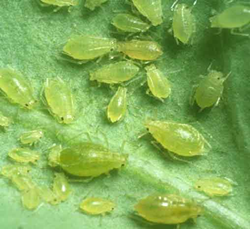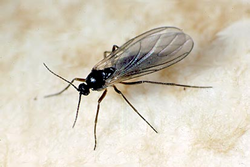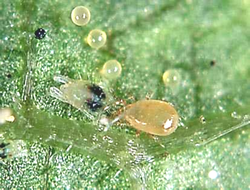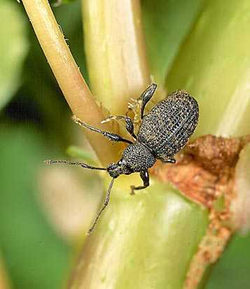|
Pest or Disease ProblemsPest or disease problems can affect many plants, particularly those under environmental stress. Kernock Park Plants uses beneficial organisms for the control of common pests such as aphids, mealybug, spider mites, whitefly etc. There are several pesticides with activity against these pests, some of which can be integrated while others have a much broader range of activity, killing most natural enemies, sometimes for several months after application. Integrated Pest Management (IPM) uses cultural techniques, biological control agents and selective or short persistence pesticides to provide long term, sustainable, pest management. It is quite practicable to use a full IPM programme that can run from year to year with just minor adjustments to correct localised pest outbreaks. This article will look at the main pests and their IPM options that are suitable for use in the majority of gardens and greenhouses. |
Pest Damage IdentificationIt is essential to be able to identify pests before they are able to proliferate; knowledge of basic biology is useful if an IPM programme is to be fully effective. Sap sucking pests such as aphids, mealybug and soft scale insects can excrete vast quantities of sticky, sugar-rich honeydew that, in addition to direct plant damage will further disfigure plants with associated growths of black sooty moulds and loss of plant vigour. Frequently the first sign of these pests is the presence of cast skins on upper leaf surfaces, shed as the larvae or nymphs develop to adulthood. Leaf distortion in the form of yellowing, folding or blistering may also be seen, particularly if the insects are carrying viruses. Spider mites are an extremely common pest with a rapid rate of reproduction when conditions are hot and dry causing minute yellow speckles that may affect whole leaves and plants. Predatory mites are available that can frequently eradicate the pest completely. Various species of thrips can cause differing types of leaf damage as well as transmitting plant viruses to a wide range of plants. The book: Biological Control in Plant Protection, written by myself and Kevin Brown with excellent colour photos by Nigel Cattlin describes the majority of pests and their biocontrols that can be found in gardens, greenhouses and orchards.
|
|
Aphids Aphids can be a seasonal pest problem when winged adults fly-in from their over wintering sites, they can increase in a short period of time causing sticky residues on leaves. The parasite Aphidius and predator Aphidoletes will easily control most aphid species. These should be introduced fortnightly at the first sign of aphids at a rate of 2 - 5 per m2 while aphids are a threat (mid March to late June). Lacewing larvae (Chrysoperla carnea) will devour most aphid species and can be used to control quite large infestations in both outdoor and protected plants. They will feed on other soft-bodied organisms including leafhopper nymphs, mealybug, scale insects, spider mite, thrips and developing whitefly. Lacewing larvae can be introduced to hedges and external borders in late April to May and again in June to provide a population of natural enemies to control a wide range of pests and help prevent pest migration into gardens. SB Plant Invigorator may be used to control 'hot spots' of aphids and other pests when applied as a contact spray; it works by physical means rather than poisoning, i.e. smothering and sticking. In depth details of this product are given further in this article. The selective insecticide Chess integrates well in IPM programmes and controls most sap sucking pests including aphids, leaf hopper, mealybug, psyllids, whitefly etc.
|
CaterpillarCaterpillar, in particular Tortrix can be controlled with routine sprays of Bacillus thuringiensis as DiPel DF, which has given excellent results. Pheromone lure traps are a very useful addition to the IPM programme they are specific for each species of moth to be caught and will attract moths from a wide radius, indicating when to begin a spray programme and often providing a degree of pest control. The parasitic wasp Trichogramma will give reasonable parasitisation of eggs from most moth species. These are introduced on cards when moths are flying i.e. mid spring to autumn, depending on weather conditions. The insect growth regulator insecticide Nemolt has amenity approval for control of several caterpillar species including Oak Processionary Moth and can be used on all ornamental plants in most situations. |
SB Plant InvigoratorSB Plant Invigorator is a mix of Linear Sulphanate and Folia Lattice with chelated iron and nitrogen that effectively acts as a tonic for the plants while killing various insect and mite pests by its physical mode of activity, it also controls powdery mildew. The insecticidal activity is by de-waxing insect cuticle while long chain molecules of the surfactant smother the now unprotected pest bodies; there is no harvest interval for edible crops and no reported phytotoxicity. The UK, CRD has stated that products acting by a non-chemical or non-biological means fall outside the European Pesticide Directive. Since SBPI has been shown to act purely by physical means, it was exempt from the legislation and therefore does not require registration as a pesticide. An extract from the safety data package sent to PSD states "None of the constituents are toxic, harmful, corrosive, sensitizing, carcinogenic or mutagenic; the preparation is non-irritant and does not present a danger to the environment". There is no residual effect and therefore applications need to be thorough to optimise the effectiveness of SBPI. Tests have shown that heavily infested plants require spraying two or three times at two or three-day intervals before routine maintenance sprays or a biological programme commences. It will also ensure that the large amounts of protective wax produced by some pest species is overcome (e.g. mealybug, woolly apple aphids, mealy cabbage aphids, bay sucker, psyllids etc). Similarly, heavy infestations of spider mite will require two or three repetitive treatments in order to overcome the protective webbing and the difficult to control eggs. Parasitoid wasps developing within host 'mummies', robust predators such as lacewing larvae, ladybirds, hoverflies etc. are not affected are not affected by SBPI, nor are Hypoaspis miles in soil or compost. However, most leaf dwelling mites (Amblyseius species and Phytoseiulus) may be affected by multiple applications. |
Sciarid flies For propagation areas or where newly potted plants are kept, the predatory mite Hypoaspis miles is ideally suited for Sciarid fly control and prevention. The mite lives in soil, compost or capillary matting and feeds on many soil dwelling pests including; thrip larvae/pupae, springtails and mealybug nymphs. The mite is best introduced as a preventative treatment to all plants, ideally within 2 weeks of potting or at the very first sign of Sciarid fly adults or larvae on the compost. Excellent results have been obtained by using Hypoaspis at 100 - 150 mites per m2 to each batch of plants, with repeat applications at 10 - 12 week intervals. Nematodes formulated as Nemasys, will provide excellent curative activity against Sciarid larvae. They should be applied to moist compost at the first sign of adult flies; the moisture content is critical as an over wet compost will drown the minute nematodes while too dry will inhibit their movement. Yellow sticky traps laid horizontally, sticky side up, will trap adult flies and can be used as an indicator as well as positive fly reduction. |
Spider mites Spider mites can survive throughout the year on a wide range of plants producing their characteristic yellow speckling feeding damage. Amblyseius andersoni is a UK sourced and produced mite available in controlled release system (CRS) sachets for hanging on plants that release mature mites continuously over a 6 - 8 week period. A. andersoni can also provide control of fruit tree spider mite (out-door and protected), russet mites and other small prey but do not perform well on severe outbreaks due to spider mite webbing. However, they survive well in surrounding areas often ambushing straying spider mites and limiting their spread. Due to their ability to survive on other food sources such as pollen, other mites and small prey they are ideal to 'seed' a susceptible crop before spider mites appear. The more voracious predator Phytoseiulus persimilis can be used as a stand alone predator for curative use, as and when needed or alongside Amblyseius species to boost their activity. The predatory mite Amblyseius californicus is tolerant to high temperatures and lower humidity’s, but is only licensed for use on plants in production within a protected structure. SB Plant Invigorator is also useful in situations where the predatory mites have been introduced and require additional help to control a severe outbreak. The spider mite lifecycle from egg to egg-laying adult is no more than 7 days at 30oC, under the same conditions Phytoseiulus becomes less active, preferring to stay lower in the crop canopy where it is cooler. |
ThripsThrips can become a major pest of many plants; usually Western Flower Thrip (WFT) and Onion Thrip although cereal thrips can cause widespread damage in late summer. Several thrip species are able to transmit plant viruses, potentially causing severe infection symptoms on the whole plant. Thrips feed by rasping the leaf surface causing distorted growth and loss of colour from flowers followed by early death. This insect is best tackled preventatively by introducing the predatory mite Amblyseius cucumeris, particularly to flowering plants. The controlled release system (CRS) is a breeding population of predatory mites in a sachet that release mated females over an area of about 1 m2 over a 6 – 8 week period. If higher numbers of thrip are found, the predatory bug Orius laevigatus will feed on all stages providing better control. Parasitic nematodes (Steinernema feltiae as Nemasys) can be sprayed on plants and compost / soil to kill adults and larvae / pupae respectively. |
Vine weevil All adult vine weevils are female, each can produce 800 - 1,000 eggs and they can live for up to 1 year so a single insect can devastate many plants. Adults feed by notching leaf edges while their larvae cause serious damage by feeding on roots and corms of many plants. Their main natural predators are ground beetles (Carabidae) but these insects are restricted to open ground areas, being unable to climb the sides of most containers and troughs. The parasitic nematode Heterorhabditis megidis as Nemasys H is the fastest curative treatment when soil / compost temperatures exceed 14oC. These nematodes can enter through the host cuticle as well as 'natural body openings', after entering the weevil larvae they release a small pellet of bacteria that kills the insect, changing it from creamy/white to pinkish red. Steinernema kraussei as Nemasys L is active from 5oC up to 25oC; both types are applied as a drench to the compost. Nemasys L is slightly slower acting but longer lived in soil or compost, providing good protection even when conditions are cold, they are best on colder outdoor beds. Annual treatments with nematodes have been shown to provide a reliable, safe method to control and prevent vine weevil outbreaks. |
WhiteflyThese small flies can attack a wide range of edible and ornamental plants, being in the same family as aphids they suck sap and produce honeydew. The parasitoid wasp Encarsia formosa was discovered in the UK in the 1920’s and is now routinely introduced to most protected crops to control and prevent whitefly. Similarly to Aphidius for aphids, the wasp lays an egg directly into the developing host larva that hatches to a minute larva to feed on the hosts internal organs, eventually killing it when it pupates. Additional IPM compatible controls for whitefly include Chess, Nemolt and SBPI. |
Plant diseasesSerenade ASO (Aqueous Solution Organic) is an innovative and highly effective broad spectrum contact bio-fungicide with several modes of action for a wide spectrum of control with little potential for resistance. Based on Bacillus subtilis QST 713, it is approved in the UK as a professional pesticide registered for Botrytis control on strawberries but with extensive SOLA notices for the majority of crops. Serenade ASO is registered throughout the world on a wide range of crops, activity is recorded against: Alternaria, powdery mildew, Bacterial cankers, fire blight, leaf spots and wilt, apple scab and Colletotrichum. The main advantages with Serenade ASO are: Organic status, zero harvest interval on edible crops, no MRL (Maximum Residue Limit) and with up to 20 applications allowed per crop it is proving to be an extremely useful product. Serenade’s multiple modes of activity come from 1) the production of lipopeptides which actively destroy pathogen cell walls, 2) elicitation of Induced Systemic Resistance and 3) colonisation of leaves to out-compete pathogens making resistance unlikely.
|
CONCLUSIONThe key points to a successful, sustainable IPM programme is to use cultural techniques to keep the system clean; biological control will keep a pest population low and can frequently eradicate pests completely. Selective pesticides can be integrated to control troublesome outbreaks. |
Neil HelyerIntegrated Pest Management in the Garden.Neil Helyer Fargro LtdLittlehampton West Sussex BN17 6PP |
 +44 (0)1579 350561
+44 (0)1579 350561 sales@kernock.co.uk
sales@kernock.co.uk